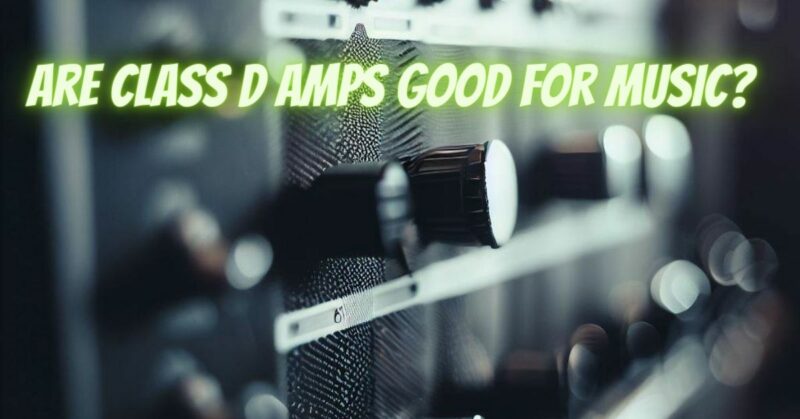Class D amplifiers, once considered the black sheep of the audio amplification family, have undergone a significant transformation in recent years. Originally designed for power-sensitive applications such as subwoofers and car audio, Class D amplifiers have made remarkable advancements, challenging traditional notions about their suitability for music reproduction. In this article, we will explore the evolution of Class D amplifiers and address the question: Are Class D amps good for music?
Understanding Class D Amplifiers:
Before delving into their musical capabilities, let’s understand the fundamental principle behind Class D amplifiers. Unlike traditional linear amplifiers (e.g., Class A, Class AB), which use continuous voltage and current to amplify audio signals, Class D amplifiers employ pulse-width modulation (PWM) to amplify the signal. They switch the output transistors on and off rapidly, representing the audio signal as a series of pulses. These rapid switching transitions result in higher efficiency and reduced power dissipation, making Class D amplifiers more energy-efficient and compact.
The Perception Challenge:
Historically, Class D amplifiers were regarded as unsuitable for high-fidelity music reproduction due to certain inherent issues in early designs. Some of the common concerns included:
- Sound Quality: Early Class D amplifiers suffered from inherent non-linearities and switching artifacts, leading to a perception of inferior sound quality compared to linear amplifiers.
- Noise and Interference: The fast switching nature of Class D amplifiers made them susceptible to electromagnetic interference and radio-frequency interference, potentially impacting audio fidelity.
- Complexity: Some Class D amplifier designs required sophisticated filtering and feedback circuits to reduce distortion, making them more complex than traditional linear amplifiers.
Advancements in Class D Amplifiers:
Over the years, significant advancements in technology and design have addressed many of the initial concerns associated with Class D amplifiers:
- Improved Sound Quality: Modern Class D amplifiers leverage advanced modulation techniques and feedback mechanisms to minimize non-linearities and switching artifacts. As a result, the sound quality of Class D amplifiers has dramatically improved, rivaling that of linear amplifiers in many cases.
- Enhanced Filtering and Filtering: Engineers have developed better filtering techniques to reduce unwanted noise and interference, leading to cleaner audio reproduction.
- Higher Sampling Rates: Class D amplifiers are now capable of handling higher sampling rates, allowing them to reproduce high-resolution audio with accuracy and precision.
- Compact and Energy-Efficient: The inherent efficiency of Class D amplifiers makes them ideal for portable and battery-powered devices, such as smartphones, wireless speakers, and headphones.
Advantages of Class D Amplifiers for Music:
- Efficiency and Heat Dissipation: Class D amplifiers’ efficiency results in less power dissipation and reduced heat generation compared to linear amplifiers, making them more reliable and cost-effective in the long run.
- Compact Size: The compact design of Class D amplifiers allows them to be integrated into space-constrained audio systems without compromising performance.
- High Power Handling: Class D amplifiers are well-suited for high-power applications, making them an excellent choice for driving large speakers and subwoofers in music systems and home theaters.
- Versatility: Class D amplifiers are highly versatile and can be integrated into various audio applications, including automotive audio, professional sound reinforcement, and consumer audio equipment.
Considerations and Limitations:
While Class D amplifiers have come a long way, it’s essential to consider some limitations:
- Critical Component Selection: The choice of components and circuit design plays a crucial role in determining the overall sound quality of a Class D amplifier. Higher-quality components generally lead to superior performance.
- Higher Output Power Distortion: At very high output power levels, some Class D amplifiers might still exhibit higher distortion compared to high-end linear amplifiers. However, this might not be noticeable at typical listening levels.
- System Compatibility: Some audio systems might have impedance or compatibility issues with certain Class D amplifiers, affecting the overall sound performance.
Class D amplifiers have undergone a substantial evolution, shedding their early reputation and proving to be formidable contenders in the realm of music reproduction. With advancements in design, engineering, and component selection, Class D amplifiers now offer impressive sound quality, efficiency, and power handling capabilities. Their versatility, compactness, and energy efficiency have made them an attractive choice for various audio applications, from portable devices to high-powered sound systems.
Ultimately, whether Class D amplifiers are good for music comes down to individual preferences, system requirements, and the specific model and design of the amplifier. As with any audio component, it’s crucial to audition and assess different Class D amplifiers to determine if they align with your sonic expectations and elevate your musical experience to new heights.


